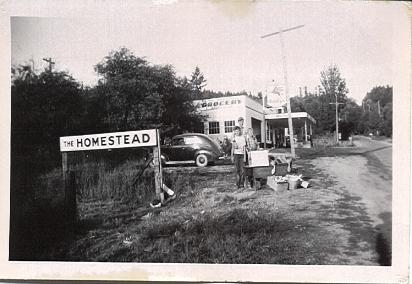




|
Apple Farm Village |
|
Specialty Retail Shopping Center |


|
Approximately 1940 |

|
Historical Perspective |
|
In 1876, the Peterson family homesteaded the land in the Sammamish Valley where Apple Farm Village is now located. There were approximately nine white settlers in the entire Sammamish Valley, stretching from Bothell to Issaquah before 1870. The country was surveyed in the Bothell area but not upriver until 1870-1871. Some tracts were marked, but no one had claimed them. By the end of 1876, there were eight or nine families living in the valley, including Arthur and Caroline Peterson, the second family to settle in the valley. Caroline Peterson was the second white woman. The Petersons first lived in an abandoned squatter’s cabin with their three sons, Robert, George and Fred, until building on the 160 acres they had staked at Hollywood, northwest of the present Hollywood intersection. Arthur Peterson worked for a while in the coal mines at Newcastle. The youngest of their four sons, Arthur was born on the property. He was the first white child born in the valley. The Homestead Grocery and gas station was located at the site of the present Chevron station. The Petersons log home was located about 150 feet north of the Homestead store. According to historical accounts, Mr. Peterson slept in a back room of the store at night. There were two Mobile Oil gas pumps in front. At that time, the main road was little more than a narrow country lane. Robert Peterson was two years old when his family moved to the valley. As the boys grew up, they were employed in the logging camps with Frank Woodin. Robert Peterson started logging with a team of disabled horses, one lame, and the other blind. He later acquired a donkey engine and a logging railroad. By 1908, he had also acquired a sawmill at Hollywood. The Bothell Sentinel, predecessor to the Northshore Citizen was founded by Fred Peterson and a partner. Mrs. Peterson, (Caroline) was a leader in the formation of the Derby Grange and sponsored early dances in the hall. Caroline also ran a boarding house at the base of the (Hollywood) Hill. She reportedly was an avid gardener. The marsh at the mouth of the Sammamish had an abundance of wild ducks which attracted the native Indians living in the area and later, sportsmen. A boathouse and hunting resort catered to them at Peterson’s Landing, near the present day Willows Lodge. The establishment consisted of a houseboat hotel, saloon and floats for mooring. One of the Peterson sons, George lived on the property until the 1940’s, when it was purchased by Roy and Goldie Olsen. They and their two sons, Tom and Robert lived on the property until the 1970’s. The Olsens were very active in the Hollywood Hills Saddle Club, raised some cattle, horses, had a kennel and planted many fruit and ornamental trees. By then, the original homestead was down to only a few acres. A portion had been sold to King County for the Little League ball fields and the present day gas station site was sectioned off about the same time. In 1975, the property was sold to Arthur Yeoman, Sr., a retired man, who lived there until 1995. Mr. Yeoman cared for the many fruit trees and each year would handpick several truckloads of apples from the property to donate to the local food bank. In 1994, Barbara Kelson purchased the property and moved three older houses, including the Calkins home to the site to be restored and utilized as retail shops.
THE CALKINS HOME The Calkins family house was moved to Apple Farm Village from Molbak’s Nursery in downtown Woodinville. Arthur Calkins came west from Illinois with his wife and sons, John and one year old Theodore in 1877 and purchased an improved homestead from a previous owner. A third son, William, was born the following year. In 1880, the Calkins home burned and a logging crew of 15 local men built another log house for the family. Mr. Calkins then worked in Seattle for a number of years before starting a nursery in Woodinville. Two of the first school board members were Ira Woodin and Arthur Peterson. Among the 10 children attending the first school in the area (no schoolhouse was available so the classes were held the first year in the Woodin home) were the two Calkins boys, John and Theodore. Later, a log cabin school was erected, and soon replaced with a small white, one room building with double desks. Property for the first frame school was donated by John Calkins. The schoolchildren would arrive along various dirt paths through the woods. Some, including the Calkins boys, arrived by rowboat. Hollywood got its start as a logging community called Derby. In 1912, Henry Stimson, a Seattle timber baron cleared the stump land where Chateau Ste. Michelle winery is now located for a poultry farm. He planted holly trees across the entire top ridge of the farm. Thereafter, the area became known as Hollywood. In the early days, Derby was not considered to be a part of Woodinville, but had its own identity. At that time, the valley was still covered with forest and marshland. |